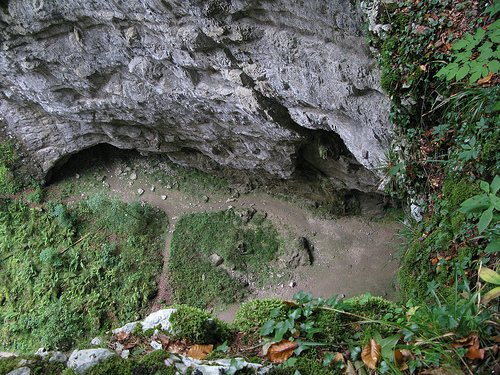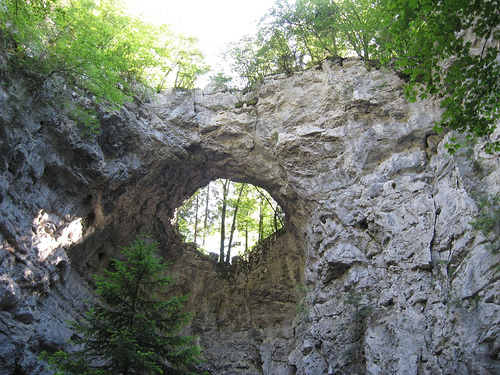

Location: Inner Carniola Map
Tel. +386 1 70 71 464, +386 41 693 124
Email: h.rakovskocjan@gmail.com
Official site

Rakov Škocjan is a picturesque valley situated 5 km West of Cerknica in Inner Carniola region of Slovenia. Rakov Škocjan was formed by a Rak River, a tributary of Pivka River. It formed two magnificent bridges. One is called Little Natural Bridge (Mali Naravni Most), while another larger Great Natural Bridge (Veliki Naravni Most) is situated within a hiking distance down stream from a village of Rakov Škocjan. This landscape park was designated in 1949. Archaeological digs here revealed that prehistoric men settled area around natural bridges to seek protection from the elements. Other artifacts also date back to Roman and Medieval times. You can get here from the Rakek train station and just get here by foot. Don't try to climb these geological formations. Limestone is fairly unstable in places due to centuries of erosion.

The name Rakov Škocjan literally means 'Škocjan of
the Rak Creek'. Like other settlements named Škocjan, the name is a
contraction of 'Saint Cantianus', referring to the patron saint of
the local church. The ruins of Saint Cantianus' Church are located
above Big Natural Bridge (Slovene: Veliki Naravni most) in Rakov
Škocjan Park.
The formation of the valley
Limestone is a relatively resistant rock , but it has the property
of being dissolved by water. After the cracks, rainwater seeps in,
which gradually melts the rock. Trenches and halls are slowly
forming in the direction of water flows. If such an underground
river flows anywhere near the surface, it may be that with the
dissolution of the rock, the cave ceiling becomes thinner and, as a
result of its own weight, eventually collapses. In the distant past,
this also happened in Rakov Skocjan. A canyon was formed, and the
fallen stone blocks were slowly dissolved by the water. Where the
plunge began today is a beautiful green valley , and on the original
and abyss can be seen gorges with bridges as the remains of a former
ceiling.
This river valley has springs on one side and sinkholes on the other
- the valley with karst inflow and outflow. In the upper part of the
valley, in the collapses of the Zelška jama caves, there is the Mali
Natural Bridge , and about 2.5 km downstream along the Rak there is
the Big Natural Bridge . The cancer originates from the Zelška caves
or from the collapses that occurred after the collapse of the cave
ceiling.
Natural sights in the park
Zelce caves with 8 to 50 m deep bumps through which the Cancer
stream can be observed.
The small natural bridge is a thin remnant of a ceiling between two
limbs, the upper edge of which is 42 m above the stream.
The large natural bridge is the remnant of a collapsed cave ceiling
on the abyss side of the stream, 23 m thick and 37 m high above the
bridge.
Sinkhole boiler with a lake, which varies in accordance with the
state of the water in the kettle.
Weaver's Cave is a 2845m long cave with two entrances, a Raka abyss
and a side impact along the road
The ruins of the church of St. Cantziana
History of Rakov Skocjan
Crab Skocjan has a long history associated with human life.
Archaeological finds of remains of Paleolithic tools prove that the
prehistoric man inhabited the wells at Rakov Skocjan in prehistoric
times . From the later Iron Age , the remains of a pottery excavated
at the church of St. Cantian were found, as well as a defensive
embankment on the west side, suggesting that the Illyrian settlement
was also there .
During the period of Turkish incursions into these places from the
15th century onwards, residents of nearby villages found themselves
there, as evidenced by the finds of remains in the collapses under
Mali Most. The first written source dates back to this period,
dating back to 1526 - this is the record of the collector of the
Haspersky village court ( Castle Haasberg near Planina). It is noted
that the church of St. Cantziana contributed a small silver chalice.
The first known description can be found in Valvasor's Glory of the
Duchy of Carniola from 1689.
